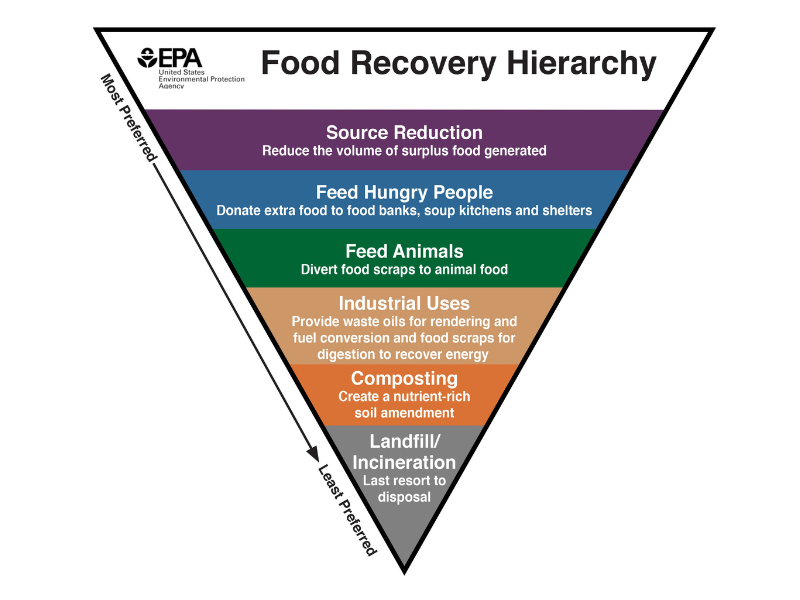The Food Waste Hierarchy and Why Compost Matters

By Jami Wong, Marketing and Communications Manager If you’ve spent any time visiting the Solana Center lately, you may have heard us talking about the EPA’s Food Recovery Hierarchy. As municipal landfills start to fill up with food waste, this inverted pyramid has become an increasingly important tool to educate our community on the steps we can take to better manage food waste.
Image Source: United States Environmental Protection Agency With an estimated 14.5 percent of American households being categorized as “food insecure” in 2012[1], it’s hard to fathom that around 35 million tons of food waste ended up in U.S. landfills and incinerators that same year.[2] Food scraps are the greatest source of municipal waste that ends up in our landfills today. And as all that food waste begins to rot, it produces methane, a potent greenhouse gas with 21 times more global warming potential than carbon dioxide. Taking a cue from the EPA’s Food Recovery Hierarchy, we can begin to reduce the amount of food wasted each year by:
- Reducing waste before it’s even created. Some easy ways of reducing food waste include buying only what we need and can use. It might be tempting to buy a full pound of carrots when they’re only a bit more expensive than a smaller bag, but unless you can use them all, think twice. If you need to buy in a larger quantity that you can’t use, think about sharing with a neighbor or friend. Or think of another dish where you can use them, like a soup stock.
- Donate excess food to people in need. Food banks, soup kitchens and shelters rely on donations to help feed people in need. Maybe you just couldn’t pass up that deal for a case of spaghetti sauce, but it’s been taking up space in the pantry for months. Rather than regretting that purchase and tossing it out, do some good by donating it to a local shelter.
- Got chickens? If you’re lucky enough to have a friend or neighbor who raises chickens or other livestock, you can easily find a way to repurpose those once fresh, crisp apples that looked so appealing in the market a few weeks ago. Fresh fruit and vegetables can be a great source of nutrients for many different types of animals.
- There’s life for all that fat, oil and grease (FOG) that the restaurant down the street uses to cook your favorite fried food. FOG should never end up in landfills or sewage systems. Instead, it can be repurposed for industrial uses, such as creating biofuels. Biodiesel is just one great example of an alternative fuel produced from waste cooking oil. It’s simple to use, biodegradable and nontoxic.
- The part of the pyramid that’s near and dear to our hearts at Solana Center is composting. In 2013, we estimate that the Solana Center was responsible for adding capacity and infrastructure to divert over 1.3 million pounds of organic waste from the landfill through our educational programs and compost bin sales. That’s in addition to an the hundreds of tons of organic waste we’ve kept out of the landfill since Solana Center started its composting programs in 1996. Instead of further burdening the landfill, all of that waste was breaking down into a nutrient-dense soil amendment to revitalize the soil throughout San Diego communities. And, as we all know, the benefits of composting are good for both the environment and the economy. Using compost can suppress plant disease and pests, reduce or even eliminate the need for chemical fertilizer, reduce or even eliminate the need for chemical fertilizers and promote higher crop yield. Because compost also helps soil retain moisture, it can even reduce the amount of water a plants needs to thrive.
- When all else fails, and we’ve exhausted every option for recovering our food waste in a responsible way, then we send it to the landfill.
Approximately 39% of the waste in San Diego County’s landfills today consists of food waste, which leaves us with lots of room for improvement. But together, as a community, we can work hard to encourage and educate each other to only buy what we can use, donate to people in need whenever possible, give those leftover celery stalks to our neighbor for her chickens, support the local restaurants that recycle the oil that creates those perfectly gold-brown French fries, and then compost. At Solana Center, our vision is to someday eliminate that lower level of the pyramid, becoming a zero-waste community. But until then, we’ll be here for you — and your neighbors — supporting our community and working to make that vision a reality for all of us.
[1]http://www.ers.usda.gov/publications/err-economic-research-report/err155.aspx#.UxWC9l7GLjk, accessed March 3, 2014.
[2]http://www.epa.gov/epawaste/conserve/foodwaste, accessed March 3, 2014.
